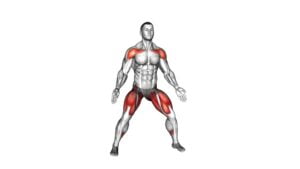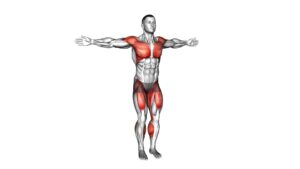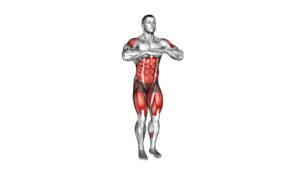Side Step Shuffles – Video Exercise Guide & Tips

Are you looking for a fun and effective way to improve your agility and cardiovascular endurance?
Watch This Exercise Video
Then side step shuffles are just what you need!
In this video exercise guide, we'll show you the proper technique for side step shuffles, along with variations and progressions to keep you challenged.
Plus, we'll share common mistakes to avoid and offer tips for a safe and effective workout.
Get ready to take your fitness to the next level with side step shuffles!
Key Takeaways
- Side step shuffles improve lateral movement, agility, quickness, and coordination.
- Proper technique includes maintaining a low and athletic stance, avoiding crossing the feet, and engaging the glutes, quadriceps, and hip abductors.
- Common mistakes to avoid include crossing the feet, leaning forward, neglecting proper form, and failing to engage the glutes and leg muscles.
- Variations and progressions include increasing speed, adding a jump, incorporating resistance, and engaging the upper body with weights or a medicine ball.
Benefits of Side Step Shuffles
What are the benefits of doing side step shuffles?
Side step shuffles are an excellent exercise for improving lateral movement and can be incorporated into sports training for various benefits.
By regularly performing side step shuffles, you can enhance your agility, quickness, and overall body coordination. These shuffles require you to move laterally, engaging your hip abductor muscles, which help stabilize your pelvis and maintain balance.
This exercise also strengthens your quadriceps, hamstrings, and calves, leading to increased power and explosiveness in your movements. Additionally, side step shuffles can improve your footwork and reaction time, essential skills in sports such as basketball, soccer, and tennis.
By incorporating side step shuffles into your training routine, you can enhance your ability to change direction quickly, evade opponents, and maintain a strong defensive stance. Moreover, side step shuffles can help prevent injuries by strengthening the muscles and tendons around your knees and ankles, promoting stability and reducing the risk of sprains or strains.
Proper Technique for Side Step Shuffles
To perform side step shuffles with proper technique, follow these steps.
First, stand with your feet shoulder-width apart, knees slightly bent, and engage your core.
Next, take a step to the right with your right foot, keeping your hips and shoulders facing forward.
Then, quickly bring your left foot to meet your right foot, maintaining a low and athletic stance.
As you shuffle to the side, make sure to keep your feet parallel and avoid crossing them over. This will help maintain correct form and prevent tripping.
Focus on engaging your glutes, quadriceps, and hip abductors to ensure proper muscle activation.
To increase the intensity, you can add resistance by using a resistance band around your ankles.
Remember to maintain a steady pace and perform the exercise on both sides to achieve balanced muscle development.
Common Mistakes to Avoid
To ensure optimal performance and avoid setbacks, it's important to be mindful of common mistakes that can occur during side step shuffles. By avoiding these technique errors, you can prevent injuries and make the most out of your workout.
Here are three common mistakes to watch out for:
- Crossing your feet: When performing side step shuffles, it's crucial to keep your feet parallel and avoid crossing them over each other. Crossing your feet not only hinders your balance and stability but also increases the risk of tripping and falling.
- Leaning forward: Another common mistake is leaning forward during the shuffle. This not only throws off your body alignment but also puts unnecessary strain on your lower back. Remember to keep your chest up, shoulders back, and core engaged throughout the exercise.
- Neglecting proper form: Lastly, failing to maintain proper form can greatly impact the effectiveness of side step shuffles. Make sure to maintain a slight bend in your knees, engage your glutes and leg muscles, and focus on quick and controlled movements.
Variations and Progressions
To continue building on your side step shuffle technique, it's important to incorporate variations and progressions into your workouts. By introducing advanced drills and modifications, you can challenge yourself and continue to improve your agility and coordination.
One way to advance your side step shuffle is by increasing the speed at which you perform the exercise. This will require quicker footwork and sharper movements, helping to enhance your reaction time and overall athleticism. You can also try adding a jump at the end of each shuffle to increase the intensity and add a plyometric element to your workout.
Another variation to consider is adding lateral resistance to your side step shuffle. This can be done by using resistance bands or ankle weights. The added resistance will engage your muscles more intensely, providing a greater challenge and helping to build strength and power in your lower body.
Additionally, you can incorporate modifications to target specific muscle groups. For example, you can perform a side step shuffle with a medicine ball or dumbbells, focusing on your upper body while still engaging your lower body through the shuffling motion.
Remember to always listen to your body and progress at a pace that's comfortable for you. Incorporating variations and progressions into your side step shuffle workouts won't only keep things interesting, but also help you continually challenge yourself and reach new fitness goals.
Tips for a Safe and Effective Workout
To ensure a safe and effective workout, it's important to follow these tips:
- Use proper workout equipment: Investing in quality workout equipment can greatly reduce the risk of injury. Make sure to choose equipment that's appropriate for your fitness level and goals. Whether it's dumbbells, resistance bands, or a stability ball, using the right equipment will help you get the most out of your workout while minimizing the chance of accidents.
- Warm up before exercising: Before diving into your workout, take the time to warm up your muscles. This will increase blood flow and flexibility, reducing the risk of strains and sprains. Incorporate dynamic stretches and light cardio exercises, such as jogging or jumping jacks, to prepare your body for the upcoming workout.
- Listen to your body: Pay attention to any discomfort or pain during your workout. Pushing through pain can lead to serious injuries. If something doesn't feel right, modify the exercise or take a break. It's better to be safe than sorry.
Frequently Asked Questions
What Are the Different Muscles Targeted by Side Step Shuffles?
When you do side step shuffles, several muscles in your lower body are targeted. This exercise is great for overall lower body strength because it engages your glutes, quads, hamstrings, and calves.
Are Side Step Shuffles Suitable for Beginners?
Side step shuffles can be a great exercise option for beginners. They offer modification options that make it easier to perform the movement at a comfortable level. By incorporating side step shuffles into your routine, you can experience several benefits for cardiovascular health.
This exercise increases your heart rate, improves endurance, and helps burn calories. It's a low-impact activity that can be adjusted to suit your fitness level, making it suitable for beginners looking to improve their cardiovascular fitness.
Can Side Step Shuffles Help Improve Agility and Coordination?
Side step shuffles are a great addition to your cardio routine. They can definitely help improve your agility and coordination. By incorporating side step shuffles into your workouts, you'll be able to enhance your ability to change direction quickly and efficiently.
This exercise also targets your lower body muscles, making it a great option for toning and strengthening. To perform side step shuffles correctly, remember to maintain a low squat position and keep your movements controlled and precise.
How Many Repetitions and Sets Should I Do for Side Step Shuffles?
To determine the recommended repetitions and sets for side step shuffles, you need to consider your fitness level and goals.
Start with 2-3 sets of 10-15 repetitions per side and gradually increase as your strength and endurance improve.
Remember to maintain proper form and avoid common mistakes like crossing your feet or leaning too far forward.
This will help you maximize the benefits of this exercise and improve your agility and coordination.
Are There Any Modifications for Side Step Shuffles for Individuals With Knee or Ankle Injuries?
For individuals with knee or ankle injuries, there are modifications available for side step shuffles.
These modifications can help reduce strain on the joints and prevent further injury.
Side step shuffles can be beneficial for rehabilitation as they help improve balance, stability, and strengthen the muscles around the knees and ankles.
Conclusion
In conclusion, side step shuffles are a beneficial exercise that can improve agility, balance, and lower body strength. By following the proper technique and avoiding common mistakes, you can maximize the effectiveness of this workout.
Additionally, incorporating variations and progressions can challenge your muscles and prevent boredom. Remember to prioritize safety and listen to your body during your workout.
With consistent practice, side step shuffles can help you achieve your fitness goals.

Author
Years ago, the spark of my life’s passion ignited in my mind the moment I stepped into the local gym for the first time. The inaugural bead of perspiration, the initial endeavor, the very first surge of endorphins, and a sense of pride that washed over me post-workout marked the beginning of my deep-seated interest in strength sports, fitness, and sports nutrition. This very curiosity blossomed rapidly into a profound fascination, propelling me to earn a Master’s degree in Physical Education from the Academy of Physical Education in Krakow, followed by a Sports Manager diploma from the Jagiellonian University. My journey of growth led me to gain more specialized qualifications, such as being a certified personal trainer with a focus on sports dietetics, a lifeguard, and an instructor for wellness and corrective gymnastics. Theoretical knowledge paired seamlessly with practical experience, reinforcing my belief that the transformation of individuals under my guidance was also a reflection of my personal growth. This belief holds true even today. Each day, I strive to push the boundaries and explore new realms. These realms gently elevate me to greater heights. The unique combination of passion for my field and the continuous quest for growth fuels my drive to break new ground.







